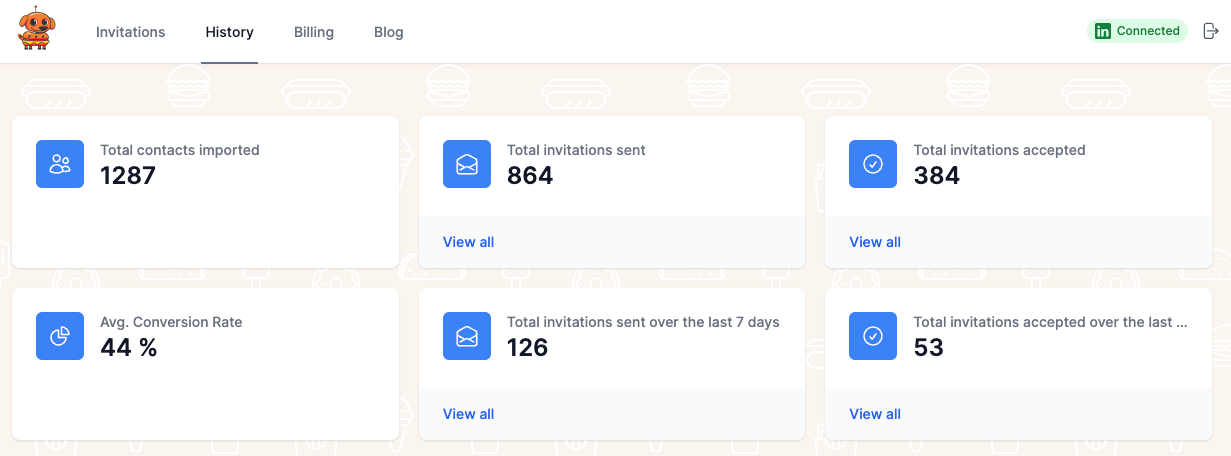A step-by-step guide to test Product Market Fit via LinkedIn
LinkedIn is a powerful platform for testing product-market fit, especially if you're targeting businesses or professionals. By leveraging LinkedIn, you can quickly gauge whether your product or service resonates with your target audience.
In this blog post, I'll share a step-by-step approach to testing product-market fit using LinkedIn, using Botdog as a concrete example throughout.
Step 1: Optimize Your LinkedIn Profile
Before you start reaching out to potential customers, ensure your LinkedIn profile is optimized to speak directly to your target audience. Here's what you should focus on:
- Crafting a compelling summary that highlights your expertise and the problem you solve for businesses. For example, if you're offering a LinkedIn automation tool like Botdog, your summary could focus on recent success with other clients, resources, etc.
- Updating your experience section to showcase relevant skills and achievements in your product's space.
- Creating a headline that grabs attention and communicates your product's value proposition.
- Earning a Top Voice Badge to establish credibility and authority in your niche.

Step 2: Identify Your Ideal Customer Profile (ICP)
Defining your ICP is crucial for effective targeting on LinkedIn. Take the time to research and identify the characteristics, job titles, industries, and pain points of your ideal customers. For Botdog.co, one ICP could be "CEOs of early stage companies based in North America and Europe, that typically went through an accelerator program like Y Combinator, Tech Stars etc.".
You can define different ICPs, go as deep as possible: list educations, countries, companies, role titles etc. (this way your messaging will also feel more relevant and personal).
Step 3: Connect with Your Target Audience
Once you have a clear picture of your ICP, add them to your network at a rate of 150 people per week (note: free accounts are limited to 50 connections per week, so a Sales Navigator account is recommended).
When sending connection requests, DON'T PITCH. Surprisingly, not using an invitation note can lead to an 80% conversion rate. Focus on growing your network with relevant individuals who fit your ICP, without being too pushy in your initial outreach.

PS: It should never feel like you're pitching!
Step 4: Nurture Your Connections
After connecting, allow some time to pass before engaging with your new connections. Here's a follow-up sequence you could use:
- Wait 5 days after connecting, then send a casual message that provides value. For example, if you're selling Botdog.co, you could share a relevant webinar recording on LinkedIn automation best practices, or this Reddit post.
- If you don't receive a response, follow up 5 days later with a gentle introduction to your product. Offer a free trial and ask for feedback.
Step 5: Scale Your Efforts
To truly test product-market fit, you need to engage with a significant number of potential customers. However, manually managing your LinkedIn outreach can be time-consuming.
Consider using LinkedIn automation tools like Botdog to streamline your efforts and execute your strategy on autopilot!
Bonus Tip #1: Focus on Learning, Not Selling
When testing product-market fit, approach conversations with a learning mindset rather than a selling one. Instead of pushing your product and seeing if people bite, use your product as a conversation starter to understand THEIR needs.
Ask open-ended questions to understand your ICP's challenges, preferences, and whether your offering aligns with their needs. This feedback will help you refine your product, messaging, and overall market positioning. You're missing all this valuable information if you're too focused on selling.
Bonus Tip #2: Give, Give, Give
Nobody likes a pitcher, especially if they don't already know you. Focus on providing value to your target audience before ever mentioning your product. Share helpful resources, insights, and tips related to the problem your product solves, establishing yourself as an expert and building trust with your network. Only after consistently providing value should you introduce your product as a solution.
For example, if you're selling a LinkedIn automation tool like Botdog, you could share free resources on optimizing LinkedIn profiles, How to get a Top Voice Badge, creating engaging content, and growing one's network organically. By providing valuable insights related to LinkedIn, you're building trust and credibility with your target audience, making them more receptive to your product when you do introduce it.
Bonus Tip #3: Take Your Time to Warm Up People
Nobody likes being sold to, but people love to buy. The benefit of connecting with people on LinkedIn is that now they'll see your posts. Take advantage of this by posting 3-5 times a week, addressing the specific pain points your product solves. By consistently showing up in your target audience's feed with valuable content, you'll warm up potential customers and make them more receptive to learning about your product.
For instance for Botdog, you could post about how to get a LinkedIn Top Voice Badge, when to post, what are the best invitations messages, what are the average conversion rates etc. By consistently addressing the pain points your product solves, you're priming your target audience to be more receptive to your solution.
Measuring Success
So, what's a good success rate when testing product-market fit on LinkedIn? Typically, if you get a 20% reply rate, that's a very good indication that your product resonates with your target audience (and that your approach is right)! Don't only look at data and conversion rates, but also verbatims, feelings from the conversations you have with people. Are they enthusiastic? Bored? Do they already use competitors?
Aim for this benchmark and use it as a signal to continue refining your product and marketing efforts! Good luck!